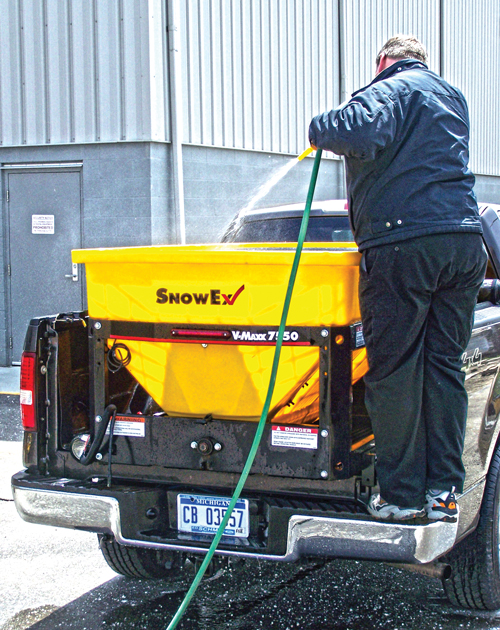Salt Spreaders

Keep It Clean
The first thing to do is give the spreader a good, thorough cleaning.
Simply propping the spreader up on its side and hosing it out with water
is all that is needed to achieve adequate cleaning. If using chemicals
during the cleaning process, keep in mind that alkaline-based cleaners
like those containing acetone, benzene, leaded gasoline or brake cleaner
should not be used when cleaning hoppers made of polyethylene, as they
can damage the structural integrity.
Take a Look
When the spreader is clean, it is the ideal time to inspect the hopper
for scratches and chips in the paint or finish. These areas should be
touched up to reduce the possibility of corrosion and rust. The only
time this step may be skipped would be for hoppers constructed of
polyethylene, simply because the poly material resists corrosion.
Components should also be looked over during this time to see if any are
in need of replacement or repair.
Treat with Grease
Speaking of components, while they will vary from one spreader to the
next, every unit will have at least some moving parts and connectors
that require lubrication. For example, units featuring electrical
connections for components should have a coat of dielectric grease
applied to all terminals. If moving parts such as bearings, chains or
conveyors exist, all need lubrication. Check the owner’s manual to
determine lubrication requirements.
Don’t Tense Up
Contractors using spreaders with belts, chains or conveyors should be
sure to adjust the tension before the season starts. This will vary
depending on the spreader, so consult the owner’s manual before making
modifications. However, some aspects of tension adjustment are
universal, such as making sure the drive belt or chain is never
over-tightened. Also, before attempting to adjust conveyor belt tension,
make sure there is no sand or deicing material trapped underneath the
belt.
Engine Extras
If an engine powers the spreader, it should also be cleaned prior to
beginning work. This can be done by simply spraying the engine with
water to remove any residual salt to guard against corrosion of metal
engine components. And don’t forget that the engine will need regular
attention throughout the season. Keep up with oil and air filter
changes, spark plug inspections and other maintenance checks suggested
by the engine’s manual.
Hints for Hydraulics
For hydraulically powered spreaders, be sure to change the hydraulic
fluid to the type and viscosity recommended by the pump manufacturer.
Also, inspect all hoses and fittings for any signs of damage or leaks.
Set to Spread
Taking just a few minutes to perform these simple tasks is all it takes
to ensure your spreader will be ready for the upcoming season. When
winter finally does arrive, the snow and ice certainly won’t be slowing
down. Make sure your spreader doesn’t either.
James Truan is the vice president of sales and marketing for SnowEx, based in Madison Heights, Mich.
